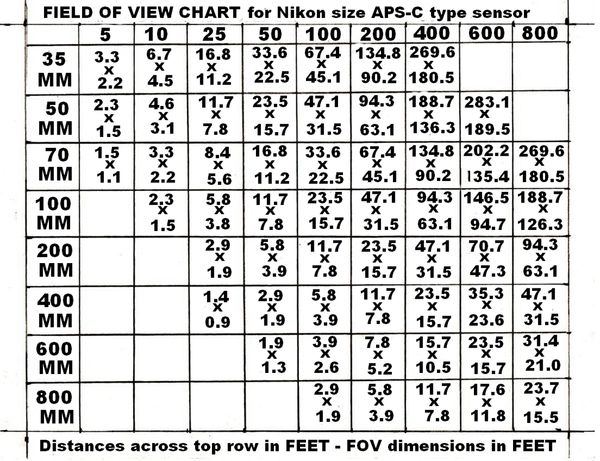Field of View Chart
Nov 1, 2013 16:33:38 #
I live in an area where there is plenty of wildlife. from squirrels to black bears, birds from tiny hummers to bald eagles. Consequently, there are many people, both locals and visitors, who are anxious to get good shots of the wildlife. I became tired of answering questions about what lens to use at what distance to photograph what bird or mammal, so I produced a Field of View chart which I could give to our visitors.
For whatever it is worth to our forum members, I am reproducing it below. The field of view dimensions are accurate to one-tenth of a foot and are based upon a camera with a so called "crop" sensor such as a Nikon D90.
For whatever it is worth to our forum members, I am reproducing it below. The field of view dimensions are accurate to one-tenth of a foot and are based upon a camera with a so called "crop" sensor such as a Nikon D90.
Field of View Chart

Nov 1, 2013 17:32:09 #
Nov 1, 2013 18:02:24 #
Nov 1, 2013 19:26:36 #
Nov 1, 2013 19:30:32 #
PhotoMan1929 wrote:
I live in an area where there is plenty of wildlif... (show quote)
Would you be willing to tell a learner how to use the chart? Thanks.
Nov 2, 2013 06:33:36 #
PhotoMan1929 wrote:
I live in an area where there is plenty of wildlif... (show quote)
You can look at this chart all day long, and most new photographers want everything to be automatic. They wont read and understand the basics of photography, the manual for their camera. All they want to do is take pictures and if they do not turn out, then they ask what is wrong nd have no interest in learning.
Nov 2, 2013 06:40:31 #
PhotoMan1929 wrote:
I live in an area where there is plenty of wildlif... (show quote)
Wow, great job, thank you
Nov 2, 2013 08:16:49 #
In reply to neco's question, the distance from you to the subject is along the top, the focal length of the lens is in the left column. The numbers within the chart are the dimensions of what you see in your viewfinder or photo.
For example, at a distance of 100' using a 400mm lens, you would see 5.8' x 3.9' (or almost 6' across and 4' vertically).
Photoman1929, you may correct me if I am wrong. I did something similar to this with a pair of binoculars when I was young. The field of view was given in degrees.
For example, at a distance of 100' using a 400mm lens, you would see 5.8' x 3.9' (or almost 6' across and 4' vertically).
Photoman1929, you may correct me if I am wrong. I did something similar to this with a pair of binoculars when I was young. The field of view was given in degrees.
Nov 2, 2013 08:27:30 #
PhotoMan1929 wrote:
I live in an area where there is plenty of wildlif... (show quote)
Interesting. I guess someone has made a chart for just about everything.
Nov 2, 2013 09:08:51 #
Nov 2, 2013 09:40:50 #
cthahn wrote:
You can look at this chart all day long, and most new photographers want everything to be automatic. They wont read and understand the basics of photography, the manual for their camera. All they want to do is take pictures and if they do not turn out, then they ask what is wrong nd have no interest in learning.
Is there anything at any time about any post that you can say anything positive?
Nov 2, 2013 09:58:50 #
cthahn wrote:
You can look at this chart all day long, and most new photographers want everything to be automatic. They wont read and understand the basics of photography, the manual for their camera. All they want to do is take pictures and if they do not turn out, then they ask what is wrong nd have no interest in learning.
I am so sorry you have such a high disregard for those of us intent on learning a new hobby. You might also want to consider learning something new. It might bring some joy to your life as photography does to mine.
I am grateful for the op taking the time to make and post his chart for others to use if they want. He gave us a gift, and his kindness and helpfulness is appreciated.
Nov 2, 2013 10:34:08 #
Essentially, if you double the mm, you halve the field of view. Simple short cut.
Nov 2, 2013 10:39:10 #
Nov 2, 2013 11:40:29 #
Photoman-Thanks for taking the time to produce the chart. A question, because it's been a long time since using math tables, for a 300mm lens are the distances equal to adding the 100mm and the 200mm? Thanks again for your time.
If you want to reply, then register here. Registration is free and your account is created instantly, so you can post right away.









